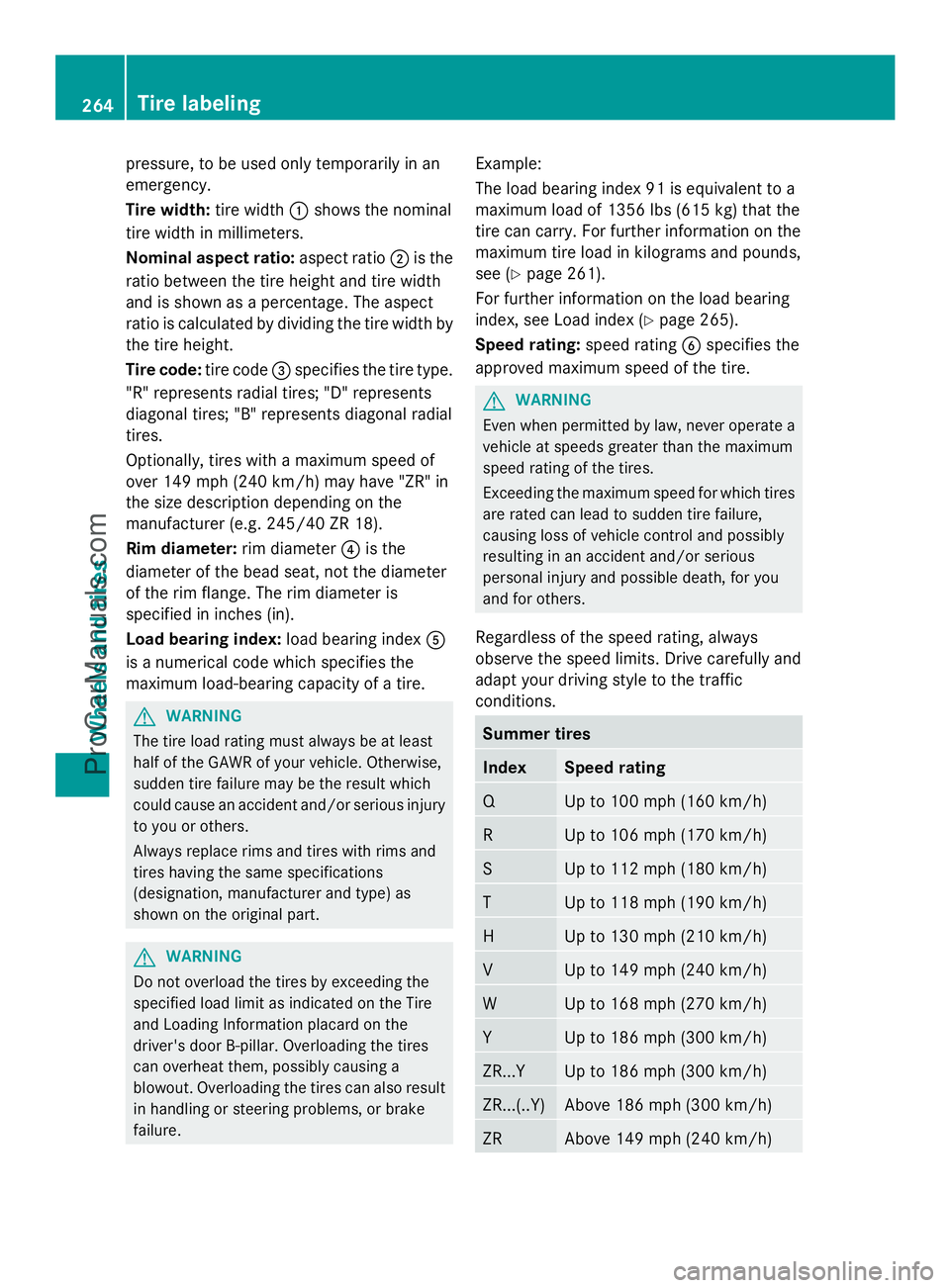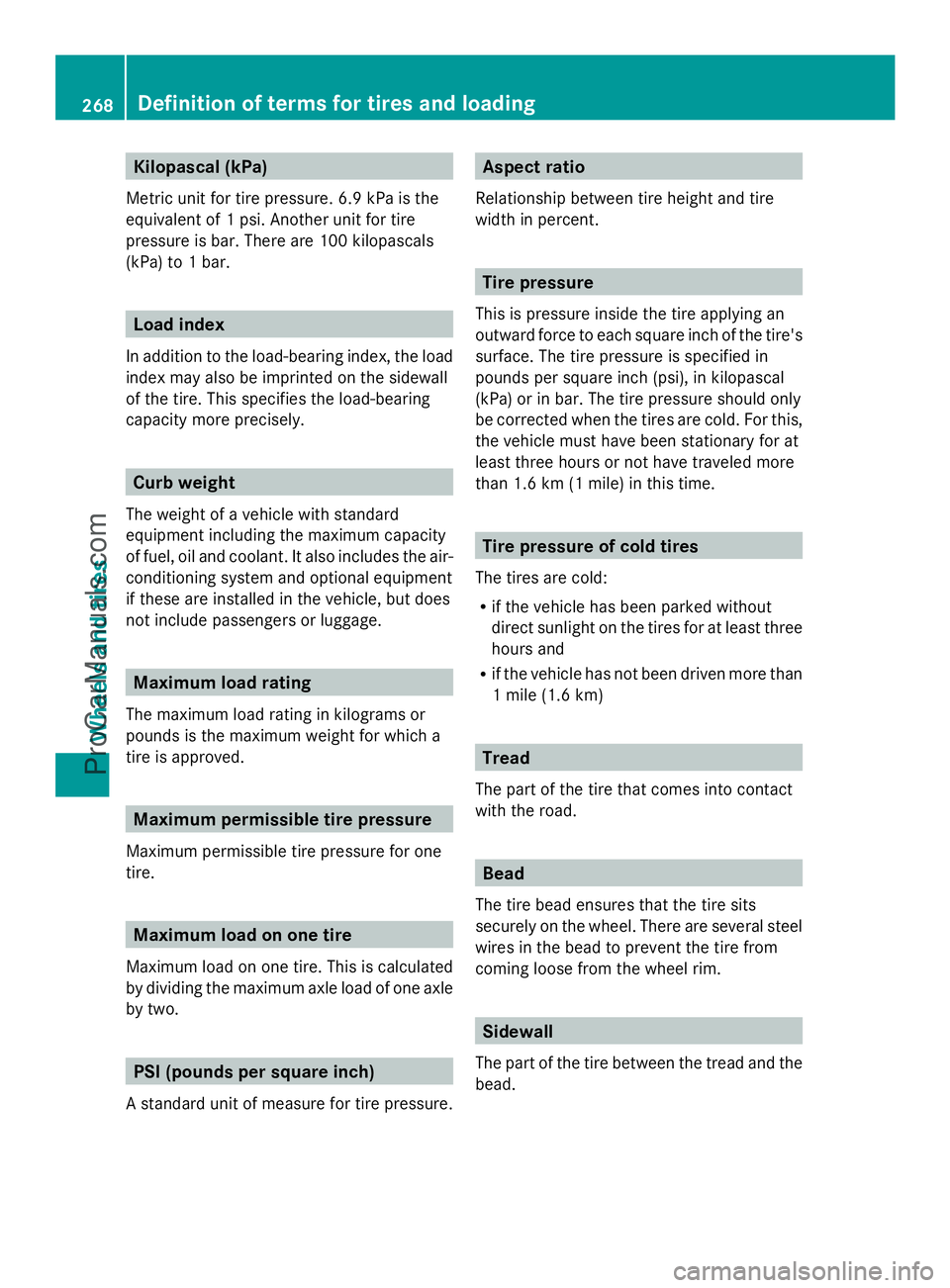Page 266 of 286

pressure, to be used only temporarily in an
emergency.
Tire width: tire width:shows the nominal
tire width in millimeters.
Nominal aspect ratio: aspect ratio;is the
ratio between the tire height and tire width
and is shown as a percentage. The aspect
ratio is calculated by dividing the tire width by
the tire height.
Tire code: tire code=specifies the tire type.
"R" represents radial tires; "D" represents
diagonal tires; "B" represents diagonal radial
tires.
Optionally, tires with a maximum speed of
over 149 mph (240 km/h) may have "ZR" in
the size description depending on the
manufacturer (e.g. 245/40 ZR 18).
Rim diameter: rim diameter?is the
diameter of the bead seat, not the diameter
of the rim flange. The rim diameter is
specified in inches (in).
Load bearing index: load bearing indexA
is a numerical code which specifies the
maximum load-bearing capacity of a tire. G
WARNING
The tire load rating must always be at least
half of the GAWR of your vehicle. Otherwise,
sudden tire failure may be the result which
could cause an accident and/or serious injury
to you or others.
Always replace rims and tires with rims and
tires having the same specifications
(designation, manufacturer and type) as
shown on the original part. G
WARNING
Do not overload the tires by exceeding the
specified load limit as indicated on the Tire
and Loading Information placard on the
driver's door B-pillar. Overloading the tires
can overheat them, possibly causing a
blowout. Overloading the tires can also result
in handling or steering problems, or brake
failure. Example:
The load bearing index 91 is equivalent to a
maximum load of 1356 lbs (615 kg) that the
tire can carry. For further information on the
maximum tire load in kilograms and pounds,
see (Y
page 261).
For further information on the load bearing
index, see Load index (Y page 265).
Speed rating: speed ratingBspecifies the
approved maximum speed of the tire. G
WARNING
Even when permitted by law, never operate a
vehicle at speeds greater than the maximum
speed rating of the tires.
Exceeding the maximum speed for which tires
are rated can lead to sudden tire failure,
causing loss of vehicle control and possibly
resulting in an accident and/or serious
personal injury and possible death, for you
and for others.
Regardless of the speed rating, always
observe the speed limits. Drive carefully and
adapt your driving style to the traffic
conditions. Summer tires
Index Speed rating
Q Up to 100 mph (160 km/h)
R Up to 106 mph (170 km/h)
S Up to 112 mph (180 km/h)
T Up to 118 mph (190 km/h)
H Up to 130 mph (210 km/h)
V Up to 149 mph (240 km/h)
W Up to 168 mph (270 km/h)
Y Up to 186 mph (300 km/h)
ZR...Y Up to 186 mph (300 km/h)
ZR...(..Y) Above 186 mph (300 km/h)
ZR Above 149 mph (240 km/h)264
Tire labelingWheels and tires
ProCarManuals.com
Page 270 of 286

Kilopascal (kPa)
Metric unit for tire pressure. 6.9 kPa is the
equivalent of 1 psi. Another unit for tire
pressure is bar. There are 100 kilopascals
(kPa) to 1 bar. Load index
In addition to the load-bearing index, the load
index may also be imprinted on the sidewall
of the tire. This specifies the load-bearing
capacity more precisely. Curb weight
The weight of a vehicle with standard
equipment including the maximum capacity
of fuel, oil and coolant. It also includes the air-
conditioning system and optional equipment
if these are installed in the vehicle, but does
not include passengers or luggage. Maximum load rating
The maximum load rating in kilograms or
pounds is the maximum weight for which a
tire is approved. Maximum permissible tire pressure
Maximum permissible tire pressure for one
tire. Maximum load on one tire
Maximum load on one tire. This is calculated
by dividing the maximum axle load of one axle
by two. PSI (pounds per square inch)
A standard unit of measure for tire pressure. Aspect ratio
Relationship between tire height and tire
width in percent. Tire pressure
This is pressure inside the tire applying an
outward force to each square inch of the tire's
surface. The tire pressure is specified in
pounds per square inch (psi), in kilopascal
(kPa) or in bar. The tire pressure should only
be corrected when the tires are cold. For this,
the vehicle must have been stationary for at
least three hours or not have traveled more
than 1.6 km (1 mile) in this time. Tire pressure of cold tires
The tires are cold:
R if the vehicle has been parked without
direct sunlight on the tires for at least three
hours and
R if the vehicle has not been driven more than
1 mile (1.6 km) Tread
The part of the tire that comes into contact
with the road. Bead
The tire bead ensures that the tire sits
securely on the wheel. There are several steel
wires in the bead to prevent the tire from
coming loose from the wheel rim. Sidewall
The part of the tire between the tread and the
bead. 268
Definition of ter
ms for tires and loadingWheels and tires
ProCarManuals.com
Page 284 of 286

At temperatures below freezing:
X
Fill the washer fluid reservoir with a mixture
of water and windshield washer fluid, e.g.
MB WinterFit.
Adapt the mixing ratio to the outside
temperature.
R Down to 14 ‡ ( Ò10 †): mix 1 part MB
WinterFit to 2 parts water.
R Down to Ò4 ‡ (Ò20 †): mix 1 part MB
WinterFit to 1 part water.
R Down to Ò20.2 ‡ (Ò 29 †): mix 2 parts MB
WinterFit to 1 part water.
i Add windshield washer fluid, e.g. MB
SummerFit or MB WinterFit, to the washer
fluid all year round.
Filling capacities Model Capacity
All models
7.4 US qt (7.0 l)
Vehicle data
General notes
Please note that for the specified vehicle
data:
R The heights specified may vary as a result
of:
-Tires
- Load
- Condition of the suspension
- Optional equipment
R The vehicle length specified includes the
front license plate adapter. Vehicle data, Coupe
The data stated here specifically refers to a
vehicle with standard equipment. Consult an
authorized Mercedes-Benz Center for the
data for all vehicle variants and trim levels. Vehicle dimensions
Vehicle length
182.7 in (4640 mm)
Vehicle width
including exterior
mirrors
81.7 in (2075 mm)
Vehicle height
49.7 in (1262 mm)
Wheelbase
105.5 in (2680 mm)
Front track
66.2 in (1682 mm)
Rear track
65.0 in (1651 mm)
Ground clearance
3.9 in (99 mm)
Turning circle
39.0 ft (11.9 m)
Vehicle weight
Maximum trunk
load
137 lb (62 kg)
Vehicle data, Roadster
The data stated here specifically refers to a
vehicle with standard equipment. Consult an
authorized Mercedes-Benz Center for the
data for all vehicle variants and trim levels. Vehicle dimensions
Vehicle length
182.7 in (4640 mm)
Vehicle width
including exterior
mirrors
81.7 in (2075 mm)
Vehicle height
49.6 in (1261 mm)
Wheelbase
105.5 in (2680 mm)
Front track
66.2 in (1682 mm)
Rear track
65.0 in (1651 mm)
Ground clearance
3.9 in (99 mm)
Turning circle
39.0 ft (11.9 m)282
Vehicle dataTechnical data
ProCarManuals.com
Page 285 of 286
Vehicle weight
Maximum trunk
load
137 lb (62 kg)
Opening dimensions of the trunk lid
Coupe
:
Opening height: 63.4 in (1,610 mm) (rear
spoiler retracted)
Opening height: 66.0 in (1,677 mm) (rear
spoiler extended) Roadster
:
Opening height: 67.4 in (1,713 mm) (rear
spoiler retracted)
Opening height: 68.2 in (1,732 mm) (rear
spoiler extended)
i The values specified may differ from the
actual values depending on the tires, load,
optional equipment and condition of the
suspension. Opening dimensions, gullwing doors
:
Range of movement exceeding vehicle
width: 14.3 in (362 mm)
; Opening height: 73.7 in (1,873 mm)
(exterior mirrors folded in)
Opening height: 76.6 in (1,946 mm)
(exterior mirrors folded in)
i The values specified may differ from the
actual values depending on the tires, load,
optional equipment and condition of the
suspension. Vehicle data
283Technical data Z
ProCarManuals.com